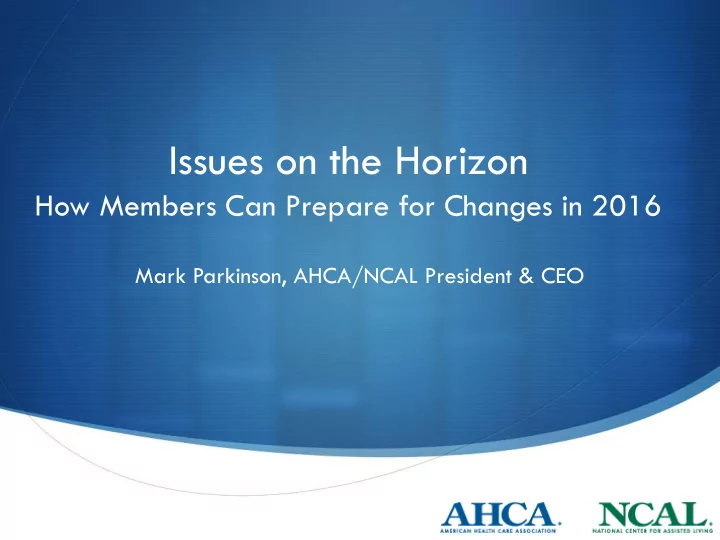

Issues on the Horizon How Members Can Prepare for Changes in 2016 Mark Parkinson, AHCA/NCAL President & CEO
Issue 1: Rehospitalization Rates
Every Payer Cares About Rehospitalization Estimated Volume of Medicare Covered Days by Payer Type Sources: CMS Office of the Actuary for spending and enrollment. Avalere analysis for alternative payment model projections.
Every Payer Cares About Rehospitalization Adding First Payment Adjustment: • October 1, 2018 Performance will be based beginning • July 2016 to July 2017 Sources: CMS Office of the Actuary for spendig and enrollment. Avalere analysis for alternative payment model projections.
Tips to Suceed Know your rehospitalization rates Reduce rehospitalizations to less than 10 -12% Review all of your rehospitalizations Assume 100% were preventable Develop robust transitions of care program Arrange follow-up and communicate with primary care MD Do follow-up calls to discharges to community within 24 hours and 3-5 days later
Issue 2: Five Star Rating
Five Star Rating: Why Does It Matter? Managed Care & ACOs use to establish networks CMS will waive 3 day hospital stay to qualify for SNF stay if SNF has 3 Star or greater rating for Hospitals in CCJR model (starting Jan 1 st ) Hospitals in Advanced ACO demonstration
Five Star Rating Adding quality measures in 2016 30 day SNF Rehospitalization Discharge back to community Change in ADL from admission to discharge Mobility in room for long stay residents Adding measures in 2017 Staffing turnover and retention Other IMPACT act quality measures (TBD)
Five Star Rating & Prediction tools
Issue 3: Mandatory Bundling of Hips and Knees
Mandatory Bundling of Hips and Knees
Mandatory Bundling of Hips and Knees Rule Goes Into Effect on April 1, 2016 Hospitals begin bearing risk on January 1, 2017
Mandatory Bundling of Hips and Knees – How To Prepare Pull your rehospitalization data Create partnerships with hospitals Evaluate risk and gain sharing
DC to community LOS Rehospitalization
Mandatory Bundling of Hips and Knees – CJR Toolkit CJR Toolkit – will start releasing pieces in late Jan 2016 Data Analytics Examples: Lower joint extremity replacement volume by MSA, rehospitalization rates Strategic Materials Examples: Guidance on liaison with hospitals in the demo MSAs, contractual guidance on how to risk-bear with hospitals National Experience Analysis Examples: AHCA member learning collaborative, AHCA quarterly summaries on CJR performance based on CMS data and AHCA analysis
Issue 4: Payroll Based Journal
Payroll Based Journal Goes into effect on July 1, 2016 PBJ staffing reported quarterly Voluntary Oct 1 st 2015 Mandatory Jul 1 st 2016 Register NOW for the voluntary submission: http://go.cms.gov/1Ok0y9M
Good News: Post-Acute Care Utilization Expected to Grow
Shift Away from Traditional FFS from 2010 to 2015, Continued but Slower Growth in Alternative Payment Going Forward Sources: CMS Office of the Actuary for spending and enrollment. Avalere analysis for alternative payment model projections.
SNF Utilization Rates Substantially Lower under MA, ACO, and Other Risk-Based Payment Models *Estimated SNF utilization per 1,000 from 2015 Medicare Trustees’ Report , CMS Office of the Actuary (OACT) **Avalere estimates that SNF utilization rates for duals participating in the demos will be 46.4 percent lower than for the FFS dual population. However, SNF utilization in the duals demo is only expected to be 6.1 percent lower than in the overall FFS population. This is because SNF utilization for duals in FFS is much higher than for non-dual FFS beneficiaries.
Population Growth – 80-84 Years 2012-2030
More People Will Need Our Post-Acute Services Source: SNF Volume from Avalere projection model; Medicare enrollment from 2015 Trustees’ Report
Final Thoughts
Final Thoughts Utilize www.LTCTrendTracker.com Apply for the Quality Award Program Embrace the Quality Initiative
Your Member Resource for… Survey History Resident Characteristics Staffing Information Cost Report & Medicare Utilization CMS Five Star Rating AHCA Quality Metrics www.ltctrendtracker.com
Quality Award Program Based on Baldrige Performance Excellence for Health Care Three levels of distinction Bronze – Commitment to Quality (5 pages) 1. Silver – Achievement in Quality (20 pages) 2. Gold – Excellence in Quality (55 pages) 3. Similar framework to CMS QAPI program Organizations must achieve the award at each level to continue to the next level
AHCA Quality Initiative 2015-2018 Improving Lives by Delivering Solutions for Quality Care Process Goal Outcome Organizational • Improve Turnover • Improve Customer Satisfaction Success • Reduce Unintended Healthcare Adopt QAPI/ Outcomes BALDRIGE informed • Safely Reduce Rehospitalization Short Stay & business • Improve Discharge to Community processes Post-Acute Care Quality • Adopt AHCA Functional Outcome and quality measures systems Long Term & • Safely Reduce Antipsychotic Use Dementia Care Quality • Safely Reduce Hospitalizations
Recommend
More recommend